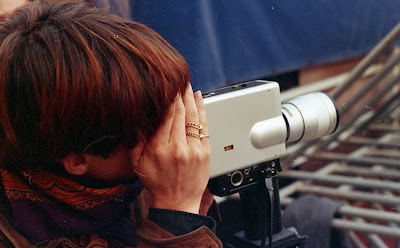Celluloid acetate is cinema’s most basic tool and has over time proven to be the most reliable image medium. Despite this fact, film material has since the 1970s slowly been replaced by video: initially, in television and the amateur sector, and subsequently in professional cinema production. Thus, analogue film material over the years has moved to a sphere of professionalism and has acquired the attributes of being pricey, complicated or virtually unobtainable. With the infrastructure for processing and postproduction of analogue film having shifted to the professional sector, working with film has become largely inaccessible for amateurs, students, and independent filmmakers or artists. Historically, things have not always been that way. Super 8 film format has persisted since 1965 and has along the way enabled countless amateurs and artists to film and project with a low-cost celluloid image medium. Likewise, 16mm has over decades evolved from a semi-professional film format to the medium of choice for TV reportages and documentaries and eventually became a cheaper alternative to shooting in 35mm for professionals.
Beirut used to be one of the only places in the Middle East that offered services for the processing of Super 8 films through the Kodak Club cine-laboratory, which existed until the late 1980s. Ironically, before being outdone by video, Super 8 processing in Lebanon came to a halt when a grenade hit Kodak’s processing machine during the civil war. Kodak still sells film stocks in Lebanon, and processing facilities for 16 and 35mm film continue to exist, mostly catering for the professional film industry.
Egypt has one of the longest cinema traditions in the world. Cairo was long known as the Eastern Hollywood, but due to both the dilapidation of the infrastructure, the generalized corruption, and the lack of democracy in its contemporary history, the Egyptian cinema has lost most of its creativity, attractiveness and grandeur. Like in Beirut, Cairo had facilities for the processing of small gauge film, and served the needs of filmmakers and amateurs on the African continent. Studios and laboratories were equipped for making 8 and 16 mm films, especially in the documentary field and for amateur filmmakers. A small laboratory was located in downtown Cairo, processing film and providing facilities for this alternative industry. However, in the 1970’s, due to the social and economic changes undergoing in Egypt this expression platform was depleted and the downtown lab was closed by the mid 1970’s.
The cinema histories of Egypt and
Lebanon have been inextricably linked. Egypt being a giant film industry for
the whole Arab market, and Lebanon, with its air of liberality, being the
preferred shooting location for Egyptian productions. The cinema culture in
Lebanon was tragically destroyed due to the multiple wars that happened over
the last forty years and is slowly getting back together in the last decade. On
the other hand the cinema industry in Egypt experienced a different kind of
crisis but is still effective and in evolution.
Today, few independent filmmakers, visual artists and amateurs in the two countries and elsewhere in the world continue to use celluloid. With the film industry abandoning its analogue hardware, however, new options have sprung up for those interested in utilizing the specific aesthetics of film. In numerous places around the world, cinema enthusiasts have formed associations in order to collectively work with film, acquire and salvage abandoned hardware, and hand-process their films within a non-commercial structure largely independent of the infrastructure that the film industry provides. The basis of these associations are the production and transfer of knowledge of how to independently work with film, aiming at making the respective techniques re-accessible to a larger number of people worldwide. If organized in a collective, collaborative, and not-for-profit environment, the critical attributes that working with film has acquired can be overcome and film practice can be located in a sphere of handicraft rather than in one of industry.
A workshop on handmade film practices, as proposed in this project, will help to make working on film re-accessible in Lebanon through a close partnership with the Cimathèque, a newly established laboratory association in Cairo. Following a basic training of four Lebanese participants in Cairo, the week-long workshop in Beirut will not focus on matters of aesthetics and content but rather on the technical, material and economical aspects of working with film, with the intention of sharing the knowledge that is needed to be able to autonomously continue this work after the workshop has ended. It shall enable its participants to learn the basic principles and techniques of working with Super 8 and 16mm film: from the handling of cameras and the specifics of reversal film stock to shooting, hand-processing, editing and projecting. Each participant shall produce one silent short film on either Super 8 or 16mm during the workshop, which will be shown at a public screening on the last day of the workshop.
This “Extension” is part of
ANALOGUE ZONES, a collaborative exchange project between Cimathèque Cairo
and the two independent film laboratories LaborBerlin and Laba Athens.
Following the establishment of a self-organized laboratory within the Cimathèque
Cairo and the training of several Cairenes in the art and technique of
working with Super 8 and 16mm film, the extension to Beirut aims at a close
exchange and knowledge transfer between Egypt and Lebanon.

LABEIRUT PHOTO DOCUMENTATION
LABEIRUT CALL FOR APPLICATION 2012
ZICO HOUSE

LABEIRUT PHOTO DOCUMENTATION
LABEIRUT CALL FOR APPLICATION 2012
ZICO HOUSE





